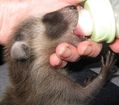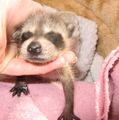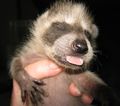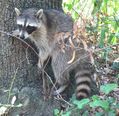|
|
HELP! I found Orphaned Baby Raccoons!
Part 1 - General Care || Part 2 - Raccoon Diseases
 |
If you do come across a baby raccoon that appears to be orphaned, you have to make sure that this is indeed the case BEFORE you pick it up!
Most older babies play during the day while their nocturnal mom is catching a nap in a nearby tree. |
So PLEASE try everything to re-unite the baby with its mother before you end up stealing it away from her and do more harm than good. Even if you picked up the baby already and brought it home, it's not too late to try to reunite the mom with her young.
It wasn’t too long ago that a man filmed himself on social media pushing a poor racoon off into the water that had snuck on to his center-console boat overnight. Florida Fish and Wildlife investigated the man and the video. This is an example of what not to do if you find a scared racoon.
How to re-unite a baby with it's mother
A lot folks believe that a raccoon seen outside during the day must automatically have rabies. That is a MYTH!
Even though it is possible that the animal is ill, most mothers and kits up to a year old will spend time outside during the day to forage for food. The kits become nocturnal at about 1 year of age.
Baby raccoons found alone that appear healthy should be left for a few hours up to a full night to give their mother a chance to retrieve them just in case she became separted from her babies and will come back for them. However, the baby needs to be protected from predators and the elements. Please follow these steps:
Step 1: Contain the babies (wear gloves!) in a bin that is too high for it to crawl out of. Or you can place a laundry basket upside-down over the baby with something heavy on top of it.
Step 2: Give the baby a heat source by placing a water bottle filled with warm water and wrapped in a towel next to the baby. Exchange the water bottle frequently so the baby won't get cold.
Step 3: Leave upright containers open (no lid) in the area where the baby was found. If the baby is left during the day and there is no shade over the container, place a flat piece of cardboard over half of the container to give the baby shelter. Protect from rain.
So, mom didn't come back and you decided it's time to intervene?
Your first reaction to finding a hungry or orphaned wild animal may be to feed it milk. DON'T! Most animals cannot digest cow's milk. It can cause severe diarhea and death.
KMR (Kitten Milk Replacer) or Esbilac (Puppy Milk Replacer) are the recommended formulas for baby raccoons. HOWEVER, DO NOT FEED IT!
 |
If not fed properly, too much, incorrectly diluted formula and the animal can aspirate the liquid into its lungs or get bloated and DIE.
In addition, if the animal is severely dehydrated and fed formula, it's also a death sentence because a dehydrated cold body is not capable of digesting anything. |
In this case electrolytes such as Pedialyte or lactated ringers are necessary. In some cases a vet is needed to to give subcutaneous injection of fluid through an IV.
So for its own good DON'T FEED THE ANIMAL! Yes, you want to help the critter which is a truly kind and noble thing to do, so, how CAN you really help?
In addition to following above advice find a licensed wildlife rehabilitator!
If you can't locate one, some local vets, animal control officers and shelters may have names of licensed wildlife rehabilitators on hand for referral. While some animal control agencies may pick up and transport the animal to a rehabber, be advised that most have no resources other than to euthanize the animal. Right now, the animal needs a trained, licensed rehabber. As an alternative to raccoons as a nuisance you can contact a humane removal service.
WORD OF CAUTION: Even though you might find it cute and adorable to have your dog to interact with your rescued raccoon(s), please keep them apart from each other at all cost!! Dogs and raccoons are natural predators. It is vital to their survival that it remains this way!
The following information is intented for the folks that are permitted/licensed to have a raccoon:
Orphaned Raccoon Care
Age Determination
 |
Raccoon kits or cubs are born very lightly furred, with a faint mask. They
typically weigh three to five ounces and 4-6 inches long with 2-2 1/4"
tail. Pigmented tail rings will either be present or will appear at
about one week of age. Their eyes are closed and so are their ears (ear
are pressed tightly forward to the head.)
The head seems large in
comparison to the rest of the body. When hungry, cold, or not in
contact with another warm body, the babies will start chattering, whine
or twitter like birds. |
They can crawl in a spider-like fashion with all
four legs in extension, but cannot climb or stand and support their
full weight. The eyes open at about two to three weeks, the ears
shortly thereafter. They now average 7-10" long.
They will be VERY
vocal at this age. They will churr, growl, hiss, and give an alarm
snort. By 4 weeks they are about 12-13" long. When five to six weeks
old, most can walk, run, and climb very well. Seven-week-old babies
will engage in active (and sometimes rough) fighting characterized by
growling, squealing, biting, wrestling, and imitating adult defense
postures. They remain in their birth den until they are about seven or
eight weeks old, at which point their mother moves them to a series of
alternate dens.
After about eight to nine weeks of age they begin
eating solid foods in the wild and by 10 weeks they are traveling with
their mother. By four months old, they will be completely weaned and
somewhat independent. Raccoon mothers with babies enjoy a privileged
position in the raccoon hierarchy for as long as the babies remain with
the mother. Other raccoons will defer to a female with babies in
feeding situations.
For rehabbers, the appropriate age for releasing
hand-raised baby raccoons back into the wild is 16 to 24 weeks. This of
course would be subject to the season of the year and the readiness of
the animal. I prefer to wait until they are at least 20-24 weeks. At
this age they are still young enough that there instincts take over and
they become truly wild following their release.
Feeding baby raccoons
 |
DON'T GIVE THEM MILK! They should be on kitten milk replacement
formula. (You can substitute baby formula or even condensed milk in an
emergency only situtation but NEVER regular milk!)
If they are
dehydrated when you get them, feed a rehydrating formula for the first
2-3 feedings and ease slowly into regular formula. |
Formula should be
heated to body temperature before feeding (100-102F). You should be
feeding them 5 times a day (that includes in the middle of the night)
for the first four weeks. Use an eyedropper (a bulb syringe really -
you can pick it up at
any vet's office or some pet stores) if they don't take to the bottle
yet (animal nurser bottle, 4 ounce size, available at pet shop or a
baby bottle with preemie nipple). Don't
overfeed! Raccoons will overeat when nursing. If their little belly
feels full, stop. It is better to feed
more often than to overfeed.
You should always feed them belly down, not on their backs. You may
find that rubbing or scratching their necks helps to stimulate them to
nurse. You may also have to burp them - just like you would a baby. You
may have to manually stimulate them to eliminate for another few
weeks. Use a cotton ball dipped in warm water, gently swap genital area
from front to back.
At 4 weeks (about a week after their eyes open), they should
probably be
up to taking at least 2 ounces or more from a bottle - start adding
some
baby rice cereal into the formula, cut it down to 4 times a day. I like
to use iron fortified baby rice cereal with banannas. At six weeks I
usually start adding a small amount of canned kitten food in with the
formula.
Baby raccoons will nurse for approximately 8 weeks and you can wean them
off the bottle onto a gruel of formula, baby cereal, and canned kitten
food (I prefer Little Friskies Turkey for kittens). Gradually work them
up to dry dog kibble as the main staple, along with a variety of fruits,
vegetables and any of nature's yummies and yuckies (minnows, etc.).
Feeding juvenile raccoons
 |
Once they are fully weaned (approximately 8-10 weeks), you
should gradually work up from a soft gruel to a high quality dry dog
kibble as the main staple. To this, you can add whatever meals, snacks
and treats you wish.
What one raccoons loves another may turn his nose
up at. Carrot lovers are rare. Most will devour uncooked corn on the
cob (and have a ball shucking it themselves) but this is not advisable
if you will be releasing them in an area near corn farms. |
Same goes for
watermelons. All my raccoons loved dog biscuits and grapes and they can
be very useful as bribes. (You may have to initially cut the grapes in
half until the raccoons discover what they are.) Raccoons have a
sweet-tooth and, while I have never given mine any, I understand they
love marshmallows.
Use any sweets sparingly. I sometimes give them dry
cat food for a change. I buy minnows and crickets at the bait shop and
the raccoons enjoy fishing and hunting for them. This teaches them
invaluable skills they will need in the wild. They also enjoy digging
for grubs and other tidbits and the nuts and berries that our trees put
forth. Basically, a raccoon will put ANYTHING it finds into its mouth.
If it tastes good to him, he eats it.
Potty training raccoons
 |
Once
a raccoon can walk, he is old enough to start training him to a
litter-box. If you use a water bowl instead of a water bottle, the
raccoon will eliminate in the water bowl.
He will then proceed to
"wash" his food in that same water. Get rid of the water bowl. Place a
litter box in the raccoon enclosure. |
If you are still in the weaning to
solid food process, place a small tin with kitty litter next to the
feeding area. If the raccoon starts to eliminate, immediately place him
in the litter. This will help speed up the process and keep him from
using his food bowl as a toilet. Raccoons will share a litterbox.
Unlike cats, they do not bury their feces. And they think nothing of
knocking the litter box over just for the fun of it. I weigh it down
with a piece of concrete under the litter.
Raccoons are the normal host for the parasitic roundworm known as
Baylisascaris procyonis. This roundworm is zoonotic, meaning it can
pass from animal to animal (or human).
Housing young raccoons
Make sure that they are warm enough. If necessary, a
heating pad wrapped in towels (if your towels have loops use a
pillowcase over them) may be used at this age but be careful. There is a non-electric heating pad marketed by SnuggleSoft that you just heat in the microwave for around four minutes and,
slipped under the bedding, provides up to 12 hours of safe, gentle,
warmth.
 |
Newborn to five week old raccoons can be housed in a
cardboard box or, better yet, a small animal carrier. It will be warmer
for them and easier for you.
Raccoons will curl together into one furry
lump for sleeping. If your raccoon does not have littermates, provide a
suitable stuffed toy as a substitute. |
As raccoons grow, so must their
enclosure but always keep a bed (den) area in it. Cardboard boxes sized
to the raccoons work well for the bed for young raccoons - line bottom
with towels for warmth. Juvenile raccoons will make short work of the
cardbox box. At that age, I prefer to start using that small animal
carrier as their bed. Depending upon the number of raccoons in the
litter, you may need a small dog carrier.
Remove the door from the
carrier - (and any other removable pieces for that matter or the
raccoons will do it for you) and place in in their enclosure. Clean and
inspect the carrier daily. One advantage of using the carrier as their
bed is that it makes it much easier when you must travel with the
raccoons, either for vet visits or their final release into the wild.
Since they feel secure in their "bed", car trips are a lot easier on
everyone involved.
Although I did have a litter once that "escaped"
from the carrier while I was driving. Actually, it was a planned
breakout - they couldn't push the door open but they managed to pull it
in. I had to pull over to the side of the road while they had a ball
exploring the car. Moral of story: to make sure they can't get the door
open while you're travelling, tie it securely rather than just relying
upon the built in locks.
Housing juvenile raccoons
 |
The type of outside enclosure you use for your raccoons will depend
upon your rehabbing methods. Up to 4 raccoons can be placed in a cage
measuring 24'X8'X8'.
Cages measuring 6'X6'X12' long are also
satisfactory. Wire should be 1"X2" welded wire. Fiberglass panels
should be placed on the ends to protect them from the weather (Evans
& Evans, 1985). |
Some rehabbers use a very large enclosure, complete
with tree(s), child's wading pool, various climbing items and other
toys, feeders, and wooden boxes for beds. They may have several litters
together and the older ones help teach the younger ones numerous
skills. Many raccoons will stay within this type of enclosure until
their final release.
They should be released in a area with feeders
that are regularly restocked until you are sure they no longer need
them.
Dealing with imprinting and other problems
While bottle feeding does make raccoons bond with you, when they are
being
rehabbed with littermates they do not imprint as heavily on their human
surrogate mother as a single orphaned one would. As they grow, they
will prefer the company of their littermates over you. If at all
possible, try to never rehab a single raccoon. Contact another rehabber
in your area and see if you can merge your rehabs once they have
received clean bills of health for distemper and roundworm.
 |
Physical
affection should be lavished upon nursing raccoons. Once they are
weaned, you need to start distancing yourself from them, to break the
human bond. Also start limiting their human contact to just yourself.
As they get older they will get quite playful, which increases the
chances of your being bit.
|
Use precaution and heavy gloves and make it
clear that they are not to rough house with you. Sharply say "NO" and
growl or hiss at them. If they are by you at the time, gently shake the
scuff of their neck while you do this.
The scuff of the neck works well
with raccoons - their moms carry them by it, shake them by it and will
pin them down by it when they really tick mom off. You grab just skin
and fur. They can't turn their head around enough to bite you and if
you pick them up that way they usually just hang there quite docile
(must be instinctive.) This should never be attempted with wild or
adult raccoons but I find it quite effective while I am still their
"mother".
Preparing a raccoon for release
At about 10 weeks of age, I start taking the raccoons for daily
excursions. At this age they will follow me like little ducklings but
as they get older the bravest of any litter can easily lead the others
quickly astray - so be prepared. A wheel barrel filled with water is
not only great fun for them play in but, when stocked with minnows,
teaches them how to fish. Rumaging around in the leaves on the ground
can yield all sorts of things to eat.
 |
I lead them to smaller isolated trees where they can be more
easily retrieved or coaxed down with a bribe. The first couple of
times, they may be a little leery and you might have to help them up
and down.
After that, they discover all the good things about trees
(food, shelter, fun) and you'll find them making a run for the trees. Then I start to let them out by themselves, gradually building up from
a few hours each day, to half a day, to overnight for a day or more at
a time.
|
Each time they visit their food bowl less and less, sustaining
themselves on nature's offerings instead, and it becomes harder and
harder to coax them to me. And sometimes they start to turn almost
nocturnal.
It is then that I make the final catch and release them into
non-hunting areas in the areas where they were born. I do leave food
and check back but it is more for me than for them - they do not need
my help anymore, they have successfully returned to the wild.
Raccoon MYTHS & Raccoon FACTS:
1. Raccoons are strictly nocturnal so a raccoon out in the daytime automatically has rabies
FALSE! Contrary to popular belief, raccoons are not nocturnal and observing them out during daylight hours does not mean the animal is ill. Raccoons are cathemeral or sometimes called metaturnal, which is defined by Wikipedia as follows: "The activity of an organism may be regarded as cathemeral when it is distributed approximately evenly throughout the 24 hours of the daily cycle, or when significant amounts of activity, particularly feeding and/or traveling, occur within both the light and dark portions of that cycle. |
2. Raccoons hibernate in the winter
FALSE! They go through a period of
decreased activity in the winter, but they do not hibernate. |
3. All raccoons are carriers of rabies
FALSE! Check your local statistics on confirmed rabies cases and read our published article about the Facts of Rabies here. |
4. Raccoons always wash their food
FALSE! It is more like "feeling"
their food. |
5. Raccoons are members of the rodent family
FALSE! They are members of the
Procyonidae family, their closest relatives are the ringtails, coatis and
coatimundis. |
6. Raccoons eat cats
FALSE! However, a raccoon is quite
capable of killing a cat if it feels threatened or ill. |
7. Raccoons don't have emotions or feelings
FALSE! Unless love and trust and contentment and
fear and anger and loneliness are not emotions but merely instincts. Why
do so many humans insist we are the only animal that has feelings?? |
8. Raccoons enjoy the "sport" of coon hunting
FALSE! I can't believe that some coonhunters insist on the raccoons enjoying the chase just as much
as the dogs or are up holed up in the tree laughing. Give me a break! Ignorance is a bliss, is all I have to say about that. |
9. Raccoons make good pets
FALSE! Rraccoons do not make good pets, they don't even make bad pets because they simply are not domesticated animals, they are wild animals. Some may consider this a generalization but in my opinion that it is generally true with rules to the exception.
Many rehabbers I know have unreleasable raccoons that have become part of their households and families, but they also know what they are doing and how to keep the animal balanced and its needs met. For
every success story, there are stories of pet raccoons that
got dumped into the wild when they get too wild to handle, which more often than not is a death sentence for them, because they never learned the skills to survive or socialize. |
|
REFERENCES
The Gable's Raccoon Rehab
Birgit Sommer, Rainbow Wildlife Rescue, Texas
Baylisascaris vs. Toxocara - University of Missouri College of Veterinary
Medicine toxocariasis - Texas Dept. of Health, Div. of Zoonosis Control
Baylisascaris procyonis - Michigan DNR Wildlife Division
Baylisascaris procyonis - University of Missouri College of Veterinary
Medicine
Enlightened response - Pacific Grove School District
Anthelmintic Drugs - University of Missouri College of Veterinary
|

